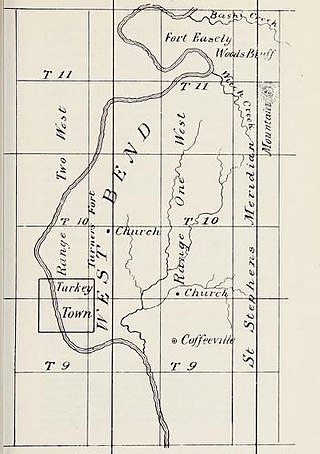
The Muscogee, also known as the Mvskoke, Muscogee Creek or just Creek, and the Muscogee Creek Confederacy, are a group of related Indigenous peoples of the Southeastern Woodlands in the United States. Their historical homelands are in what now comprises southern Tennessee, much of Alabama, western Georgia and parts of northern Florida.

The Battle of Horseshoe Bend, was fought during the War of 1812 in the Mississippi Territory, now central Alabama. On March 27, 1814, United States forces and Indian allies under Major General Andrew Jackson defeated the Red Sticks, a part of the Creek Indian tribe who opposed American expansion, effectively ending the Creek War.

The Creek War was a regional conflict between opposing Native American factions, European powers, and the United States during the early 19th century. The Creek War began as a conflict within the tribes of the Muscogee, but the United States quickly became involved. British traders and Spanish colonial officials in Florida supplied the Red Sticks with weapons and equipment due to their shared interest in preventing the expansion of the United States into regions under their control.
Red Sticks —the name deriving from the red-painted war clubs of some Native American Creek—refers to an early 19th century traditionalist faction of Muscogee Creek people in the Southeastern United States. Made up mostly of Creek of the Upper Towns that supported traditional leadership and culture, as well as the preservation of communal land for cultivation and hunting, the Red Sticks arose at a time of increasing pressure on Creek territory by European American settlers. Creek of the Lower Towns were closer to the settlers, had more mixed-race families, and had already been forced to make land cessions to the Americans. In this context, the Red Sticks led a resistance movement against European American encroachment and assimilation, tensions that culminated in the outbreak of the Creek War in 1813. Initially a civil war among the Creek, the conflict drew in United States state forces while the nation was already engaged in the War of 1812 against the British.

William Weatherford, also known after his death as Red Eagle, was a Creek chief of the Upper Creek towns who led many of the Red Sticks actions in the Creek War (1813–1814) against Lower Creek towns and against allied forces of the United States.

John R. Coffee was an American planter of English descent, and a state militia brigadier general in Tennessee. He commanded troops under General Andrew Jackson during the Creek Wars (1813–14) and the Battle of New Orleans in the War of 1812.
James White was an American pioneer and soldier who founded Knoxville, Tennessee, in the early 1790s. Born in Rowan County, North Carolina, White served as a captain in the county's militia during the American Revolutionary War. In 1783, he led an expedition into the upper Tennessee Valley, where he discovered the future site of Knoxville. White served in various official capacities with the failed State of Franklin (1784–1788) before building James White's Fort in 1786. The fort was chosen as the capital of the Southwest Territory in 1790, and White donated the land for a permanent city, Knoxville, in 1791. He represented Knox County at Tennessee's constitutional convention in 1796. During the Creek War (1813), White served as a brigadier general in the Tennessee militia.
Peter McQueen was a chief, prophet, trader and warrior from Talisi He was one of the young men known as Red Sticks, who became a prophet for expulsion of the European Americans from Creek territory and a revival of traditional practices. The Red Sticks attracted a majority of the population in the Upper Towns in the early nineteenth century. From open conflict with the Lower Towns in the Creek War, the Red Sticks were drawn into conflict with the United States after being attacked by territorial militia.

The Fort Mims massacre took place on August 30, 1813, at a fortified homestead site 35-40 miles north of Mobile, Alabama, United States, during the Creek War. A large force of Creek Indians belonging to the Red Sticks faction, under the command of headmen Peter McQueen and William Weatherford, stormed the fort and defeated the militia garrison.

The Canoe Fight was a skirmish between Mississippi Territory militiamen led by Captain Samuel Dale and Red Stick warriors that took place on November 12, 1813 as part of the Creek War. The skirmish was fought largely from canoes and was a victory for the militiamen, who only had one member wounded. The victory held little military value in the overall Creek War but its participants gained widespread notoriety for their actions during the fight. The fight has been depicted in multiple illustrations, but only a historical marker currently exists near the site of the fight.
Ferdinand Leigh Claiborne was an American military officer most notable for his command of the militia of the Mississippi Territory during the Creek War and the War of 1812.

The Battle of Autossee took place on November 29, 1813, during the Creek War, at the Creek towns of Autossee and Tallasee near present-day Shorter, Alabama. General John Floyd, with 900 to 950 militiamen and 450 allied Creek, attacked and burned down both villages, killing 200 Red Sticks in the process.

Neamathla (1750s–1841) was a leader of the Red Stick Creek. His name, in the Hitchiti language, means "fat next to warrior", "fat" being a reference to great courage. The Hitchiti language had no written form, but modern scholars agree that Eneah Emathla is the "proper" spelling of his name in English; however, there were two other men also named Eneah Emathla, so the modern convention is to use the spelling Neamathla for the leader.
The Scott Massacre, coming after the recent (1813) Fort Mims massacre, was a factor convincing the United States that the Creeks must be defeated, beginning the Seminole Wars. It took place at the end of November, 1817. Several hundred Creek warriors known as Red Sticks, led by Homathlimico, with Josiah Francis in the rear, attacked a vessel commanded by Lieutenant Richard W. Scott. The boat was heading up the Apalachicola River to supply Camp Crawford on the Flint River in southwest Georgia; the attack was at the confluence of the rivers. Besides the supplies, the boat carried 20 sick soldiers, seven women, four children, and a guard of 20 armed soldiers. After a bloody massacre and scalping, only seven survived, one woman, and six soldiers who escaped by jumping into the river and swimming to the opposite shore, where friendly Creeks helped them reach safety at Camp Crawford on December 2, 1817.
Fort Carney was a stockade fort built in 1813 in present-day Clarke County, Alabama, during the Creek War.

Fort Easley was a stockade fort built in 1813 in present-day Clarke County, Alabama during the Creek War.

Fort Glass was a stockade fort built in July 1813 in present-day Clarke County, Alabama during the Creek War.

Fort Madison was a stockade fort built in August 1813 in present-day Clarke County, Alabama, during the Creek War, which was part of the larger War of 1812. The fort was built by the United States military in response to attacks by Creek warriors on encroaching American settlers. The fort shared many similarities to surrounding stockade forts in its construction but possessed a number of differences in its defenses. The fort housed members of the United States Army and settlers from the surrounding area, and it was used as a staging area for raids on Creek forces and supply point on further military expeditions. Fort Madison was subsequently abandoned at the conclusion of the Creek War and only a historical marker exists at the site today.
Fort Montgomery was a stockade fort built in August 1814 in present-day Baldwin County, Alabama, during the Creek War, which was part of the larger War of 1812. The fort was built by the United States military in response to attacks by Creek warriors on encroaching American settlers and in preparation for further military action in the War of 1812. Fort Montgomery continued to be used for military purposes but in less than a decade was abandoned. Nothing exists at the site today.
Fort Pierce, was two separate stockade forts built in 1813 in present-day Baldwin County, Alabama, during the Creek War, which was part of the larger War of 1812. The fort was originally built by settlers in the Mississippi Territory to protect themselves from attacks by Creek warriors. A new fort of the same name was then built by the United States military in preparation for further action in the War of 1812, but the fort was essentially abandoned within a few years. Nothing exists at the site today.













